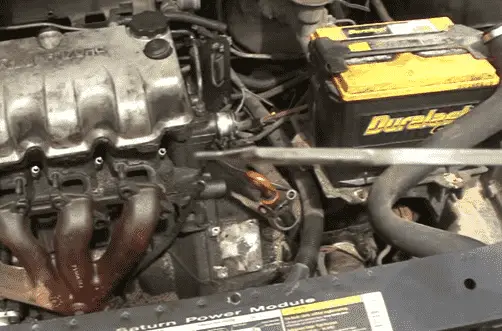How to flush milky oil from engine? We know you are here to know the tricks to remove milkshake oil from your engine. And we will feed you providing three alternative methods to flush the milky way.
Before heading over to those tricks, we let you know what causes milky oil in an engine first. If you can’t address the reasons, you will get no luck by following the ways of flushing oil from the engine.
You know milky-oil is water-contaminated oil caused by either a head gasket failure or an oil/coolant heat exchanger failure (not many cars have this).
Once you resolve those issues, you are ready to apply any of the tricks from below to flush milky oil from the engine.
Table of Contents
How To Flush Milky Oil From Engine [3 Easy Methods]
This chapter will help you know the best way to flush milky oil from the engine. So, keep scrolling till the end.
01. Run It For A While With New Oil
Drain out the milky oil as much as you can. Then, pour new oil into your engine and run your vehicle for a while with the new oil. The heat should burn out most of the moisture in the oil. We recommend you run the engine for at least 30 minutes at operating temperature. Again, drain the oil and refill your engine with the new oil.
Of course, don’t forget to change the filter. We suggest driving on this for about 100-500 miles. In this stage, check the stick and let it roll if it looks good. If it still suspects, drain the oil and refill with new oil again and drive as normal.
02. Use Diesel Fuel
Pouring diesel fuel into your engine is another practical method to flush milky oil. Just pour a gallon of diesel fuel into the motor after draining the old oil. Then, leave it for a few minutes to let the diesel sit. It will break down the sludge and help rinse away the dirty oil from the internal surfaces.
Keep in mind; you should use diesel as a type of rinse agent, not cranking the motor with diesel. Drain and repeat this method until clear diesel comes out. Finally, refill your engine with normal oil and drive with it.
Note: Ensure you drain all the diesel fuel from the engine. Otherwise, it will break down your normal oil and thin it out so much, which may hammer the bearings and reduce the life of your vehicle engine.
03. Try Out Rislone
Rislone is known as an engine treatment oil. It removes sludge, deposits, and milkshake engine oil efficiently. If you don’t encounter the trouble of removing diesel fuel, you can use Rislone as an alternative to flush out milky oil.
Just pour this engine oil into your car and drive your car 500 miles. Then, remove the cover and you can find the engine spotless. The Rislone oil is also effective to free up stuck rings on diesel engines that never allow your engine to warm up.
Flushing Milky Oil From Engine: The Cost
It’s typical to say how many bucks you need to spend for flushing the milky oil. Actually, it depends on what elements you are going to use and what methods you are going to follow. Basically, you need these three ingredients to flush the milky oil from the engine:
- Oil filter
- Some diesel or flushing engine oil
- New engine oil
If you do this task, you may need to spend around $20 to $30 bucks to flush the engine oil. We recommend you do this task by yourself as it’s a simple workflow.
How Much Water Does It Take To Make Oil Milky
It actually depends on the oil type and how much water you add. Approximately, you should add 10 milliliters of water per liter of oil to make the oil milky. The more water you will add, the more milky the oil will be.
To get the oil in the milkshake stage, you must add at least 100 milliliters of water to one liter of oil. However, we never want the oil of your engine to get turned into milky.
Basically, the oil gets milky when the coolant mixes with it. And a blown-out head gasket or a broken radiator can cause the coolant to leak into the oil pan and make the oil milky.
How To Remove Water From an Engine Crankcase?
It’s pretty simple to remove water from an engine crankcase. Just open the drain plug and let the oil and water drain. We suggest you keep the drain plug open until all the water comes out of the engine crankcase.
Once you see the oil is coming, close the drain plug again and leave it for a few minutes. It will allow the oil and water to separate again. Then, open the plug again and drain the oil.
Once you flush away all the oil and water, add some cheap oil to the engine. Then, run the engine for a while. Next, drain the oil again. After that, refill the engine with fresh oil. You can repeat this until the milky appearance of the oil goes in vain.
FAQs:
Does milky oil always mean head gasket?
No, milky oil doesn’t mean it’s the problem with the head gasket. Coolant leaking into your pan is also responsible for milky oil.
How do I know if my Headgasket is blown?
The head gasket is designed to control engine coolant in and around the engine block and cylinder heads. When they fail, they can cause a leak which can be found by removing all the spark plugs. Pressurize the coolant system and crank the engine over while observing the spark plug holes. If coolant is present at any of the holes, the head gasket is blown.
What makes engine oil look milky?
Milky engine oil is a sign of coolant in the oil. And this coolant will make the engine oil look milky. A blown head gasket, cracked casings, or a failed transmission cooler are responsible for this issue.
Can I drive my car with milky oil?
No, you can’t drive your car with milky oil. Because milky oil provides no lubrication and causes more friction, heat, and abrasion, which will reduce the longevity of your engine.
How long can you drive with milky oil?
You shouldn’t drive your car a single mile with milky oil as it damages your engine by friction & abrasion.
Conclusion
A blown head gasket or a failed coolant heat exchanger is the culprit behind milky oil in the engine. First, you should solve these faults. Then, follow any of the three methods we mentioned to flush milky oil from the engine. You can also use or pour engine flushing oil like Rislone to remove milky oil from the engine.
If still, you can’t remove the milky oil, we bet you have a serious problem. In this case, you should bring your car to a state-certified automobile mechanic to fix this issue.



About John M
John contributed as a technical head at an automobile company just 2 years after his post-graduation in Automobile Engineering. He loves to lead a free life, so he left his job & started blogging. Now, he does research on every automotive problem, part & product and seeks a better solution & best products & shares his findings with his readers to help them as well as to minimize their struggle.